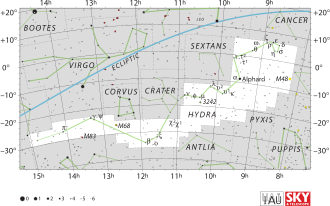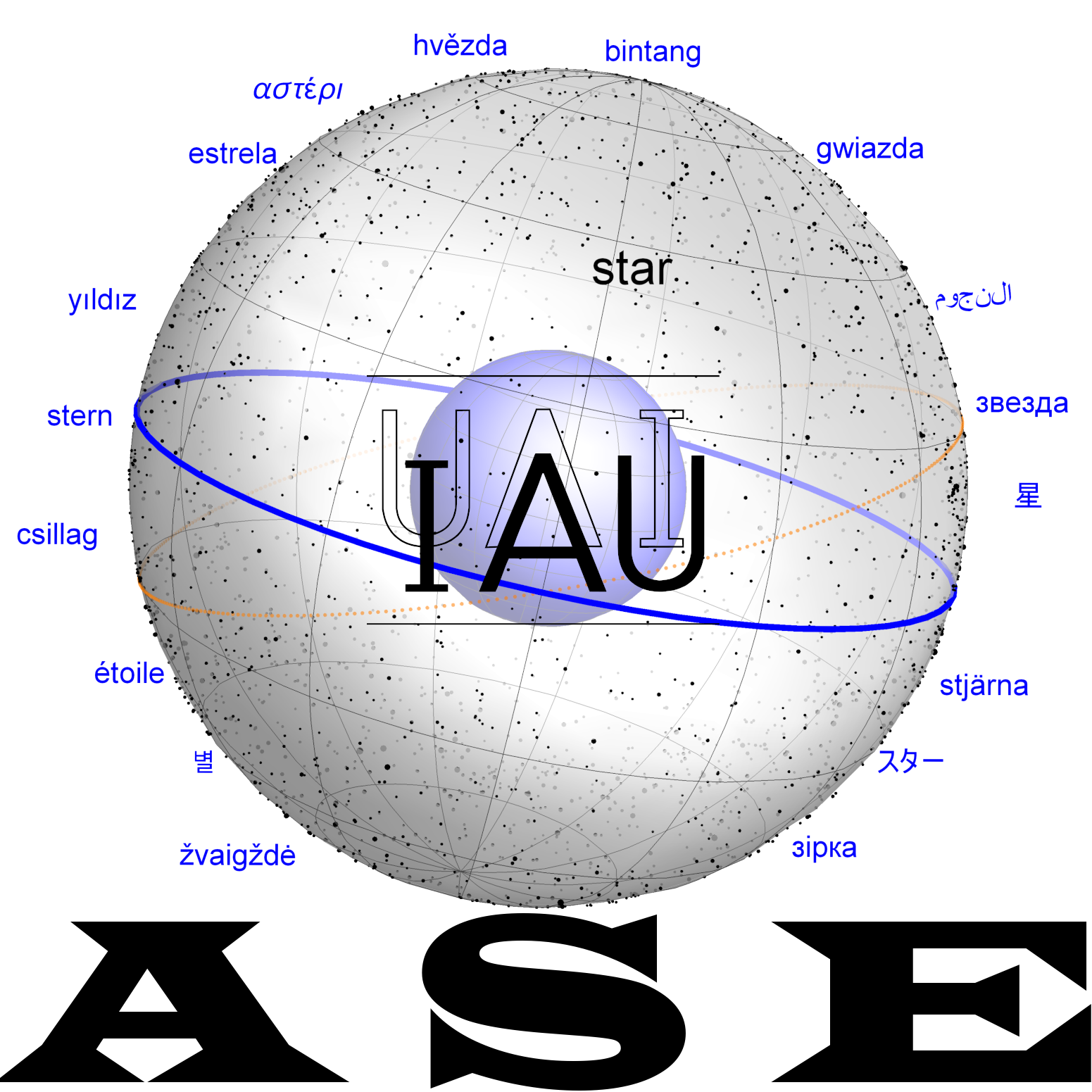Hydra: Difference between revisions
| Line 67: | Line 67: | ||
| |
| |
||
|Lib. III. Cap. III. § 5. |
|Lib. III. Cap. III. § 5. |
||
|} |
|||
| ⚫ | |||
{| class="wikitable" |
|||
|+ |
|||
!Greek |
|||
!German |
|||
!English |
|||
! |
|||
|- |
|||
| |
|||
|Der nördlichere von denen im Rachen (δ). |
|||
| |
|||
| |
|||
|- |
|||
| |
|||
|Der aro Ende des Schwanzes (π) |
|||
| |
|||
| |
|||
|- |
|- |
||
| |
| |
||
| Line 73: | Line 91: | ||
| |
| |
||
|} |
|} |
||
| ⚫ | |||
| ⚫ | |||
| ⚫ | |||
Dauer des Aufgangs : 7 1/15 St. = 424m = 106°. |
|||
| ⚫ | |||
| ⚫ | |||
Further stars mentioned |
Further stars mentioned |
||
{| class="wikitable" |
{| class="wikitable" |
||
Revision as of 21:13, 4 March 2025
One of the 88 IAU constellations. The name "Hydra" refers to a watersnake from Greek mythology. Still, the underlying constellation originally referred to a Babylonian creature that consisted of a dog-headed snake with wings, the MUŠ.
Etymology and History
The Greek constellation of the Water Snake is a derivative of the Babylonian constellation of the MUŠ-Dragon, a dog-headed creature with the body of a gigantic snake with front legs and wings.
Origin of Constellation
The Babylonian constellation is mentioned as early as 2nd millennium BCE; it occurs in lexical texts and texts of the Three Stars Each-genre. It is also mentioned in the first list (uranology) of MUL.APIN, where the Raven (or Crow) is mentioned at the tip of tail of the huge creature in the sky.
Aratus
The Greek poet Aratus has many Babylonian references; some of them hidden. For him, this constellation is a (Greek) watersnake.
- [443] Another constellation trails beyond, which men call the Hydra. Like a living creature it winds afar its coiling form. Its head comes beneath the middle of the Crab, its coil beneath the body of the Lion, and its tail hangs above the Centaur himself. Midway on its coiling form is set the Crater, and at the tip the figure of a Raven [Corvus] that seems to peck at the coil.
- [449] There, too, by the Hydra beneath the Twins brightly shines Procyon. [51x] and the coil of the gleaming Hydra: in it, too, the dim-lit Crater and the Crow and the scanty-starred Claws and the knees of Ophiuchus are borne.
- [595] Up rises the Hydra’s head and the bright-eyed Hare and Procyon and the forefeet of the flaming dog.
- [600] The Hydra rises higher as far as Crater, and before her the Dog brings up his hind feet, dragging behind him the stern of Argo of many stars.
- [607] Nor can the rising Claws [Libra], though faintly shining, pass unremarked, when at a bound the mighty sign of Boötes rises, jeweled with Arcturus. Aloft is risen all of Argo, but the Hydra, shed as she is afar over the heavens, will lack her tail.
- [663] So she is borne towards the West, but other signs in the East the vault of heaven brings from below, the remaining half of the Crown and the tail of the Hydra, and uplifts the body and head of the Centaur and the Beast that the Centaur holds in his right hand. But the fore-feet of the Centaur-Knight await the rising of the Bow. => pi Hya gehört für Aratus dazu But she sinks beneath the verge the coiling neck and all the brow of the gleaming Hydra.
- [700] Yet many a coil of the Hydra remains, but Night engulfs her wholly with the Centaur, when the Fishes [Pisces] rise; with the Fishes the Fish which is placed beneath azure Aegoceros rises
Eratosthenes
Hipparchus
| Greek | German | English | |
|---|---|---|---|
| weiter giebt Eudoxos auch die auf den sogenannten Kolurkreisen gelegenen Sterne an und behauptet, auf dem einen derselben liege die M:itte des Großen Bären, die Mitte des Kreises, der Nacken der Wasserschlange und von der Argo das Stück zwischen dem Hinterteil und dem Mastbaum; alsdann nach dem unsichtbaren Pol der Schwanz des südlichen Fisches, die Mitte des Steinbocks und die Mitte des Pfeils; endlich gehe er durch den Hals und den rechten Flügel des Schwans, durch die linke Hand des Kepheus, durch die Windung der Shlange und vorbei am Schwanze des Kleinen Bären. | Lib. I. Cap. XL § 9 . | ||
| Ersichtlich macht er dies auch bei dem Aufgange der Fische, wo er sich also ausdrückt; nachdem er nämlich von der Wasserschlange gesagt, daß das Stück vom Kopfe bis zur ersten Windung, wenn der Wassermann im Aufgange begriffen ist, nicht mehr über dem Horizont sei, während den Rest ihres Körpers die Fische hinabführen. | Lib. II. Cap. I. § 24 | ||
| Untergang des Perseus, mitkulminierend:
Leo 5 1/2: Von der Wasserschlange der vierte von den vier hinter dem hellen nach Osten gelegenen (λ2), 1 Mbr. westlich des Meridians. |
|||
| Aufgang des Kentaur, mitkulminierend:
Cnc 12°: Von der Wasserschlange der nachfolgende in der südlichen Kinnlade (η) |
Lib. III. Cap. I. § 4. | ||
| Untergang Kleiner Hund, mitkulminierend:
3 . Von der Wasserschlange der am Ende des Schwanzes (π). |
Lib. III. Cap. n. § 13 | ||
| Aufgang der Jungfrau, mitkulminierend:
2. Von der Wasserschlange der nördlichere von denen im Rachen (δ) , 1 Mbr. östlich des Meridians. |
Lib. HI. Cap. III. § 3 | ||
| Aufgang des Skorpions, mitkulminierend:
Von der Wasserschlange von den vieren nach dem hellsten [vor dem Becher] der dritte von Westen (ν2 Hydrae) |
Lib. III. Cap. III. § 5. |
The mathematical astronomer mentions this constellation rising and setting.
| Greek | German | English | |
|---|---|---|---|
| Der nördlichere von denen im Rachen (δ). | |||
| Der aro Ende des Schwanzes (π) | |||
- The first star rising is ,
- the last star rising is the one at the tip of the tail (ὁ ἐν ἄκρᾳ τῇ οὐρᾷ).
Dauer des Aufgangs : 7 1/15 St. = 424m = 106°.
Further stars mentioned
| Greek
(Manitius 1894) |
German
(Manitius 1894) |
English
(...) |
|
|---|---|---|---|
| Von der Wasserschlange |
Almagest
| Greek
(Heiberg 18xx) |
English
(Toomer 1984) |
ident. | ||
|---|---|---|---|---|
| 1 | The 5 stars in the head: the southernmost_of the 2 advance ones, which is on the nostrils | sig Hya | ||
| 2 | The 5 stars in the head: the northernmost of these [2], which is above the eye | delta Hya | ||
| 3 | The 5 stars in the head: the northernmost of the 2 to tl1e rear ofthese, which is about on the skull | eps Hya | ||
| 4 | The 5 stars in the head: the southernmost of them, on the gaping jaws | eta Hya | ||
| 5 | The 5 stars in the head: the reannost of all, about on the cheek | zet Hya | ||
| 6 | The more advanced ofthe 2 star~ in the place where the neckjoins [the head) | omega Hya | ||
| 7 | The rearmost of them | theta Hya | ||
| 8 | The middle star of the following three in the bend of the neck | tau2 Hya | ||
| 9 | The rearmost of the 3 | iota Hya | ||
| 10 | The southernmost of them | tau1 Hya | ||
| 11 | The faint, northernmost star of the 2 close tagether to the south | BSC 3750 | ||
| 12 | The bright one of these two close stars | alpha Hya | ||
| 13 | The most advanced ofthe 3 stars to the rear, afl:er the bend [in the neck | kappa Hya | ||
| 14 | The middle one | upsilon1 Hya | ||
| 15 | The rearmost of the three | upsilon2 Hya | ||
| 16 | The most advanccd of the ncxt 3 stars almost on a straight line | mu Hya | ||
| 17 | The middle one | phi Hya | ||
| 18 | The rearmost of the three | nu Hya | ||
| 19 | The northernmost of the 2 stars aher [i.c. to the rear o.t] the base of Crater | beta Crt | ||
| 20 | The southernmost of thcm | chi1 Hya | ||
| 21 | The most advanced of the 3 stars aller these, as it werc in a triangle | xi Hya | ||
| 22 | The middle and southernmost onc | omicron Hya | ||
| 23 | The rearmost of the three | beta Hya | ||
| 24 | The star after Corvus, in the scction by the tail | gamma Hya | ||
| 25 | The star on the tip of the tail | pi Hya | ||
| Stars round Hydra outside the constellation: | ||||
| 26 | The star to the south of the head | BSC 3314 | ||
| 27 | The star some distance to the rear of those in the neck [ nos. 6-I5] | epsilon Sex | ||
Transfer and Transformation of the Constellation
Mythology
Greek/ Greco-Roman folklore
Babylonian belief
IAU WGSN
The star pi Hydrae is very important in history as it is one of the keywitnesses for transfer from Hipparchus to Ptolemy.
- name in Hipparchus: ὁ ἐν ἄκρᾳ τῇ οὐρᾷ (the one at the farthest point of the tail)
- name in the Almagest: ὁ ἐπ᾽ἄκρας τῆς οὐρᾶς (the one at the end of the tail)
The Greek term ἄκρᾳ can be translated as "at the farthest point" or "at the end" (or "hightest" which doesn't apply here).








